An indigenous farm-forestry demonstration trail
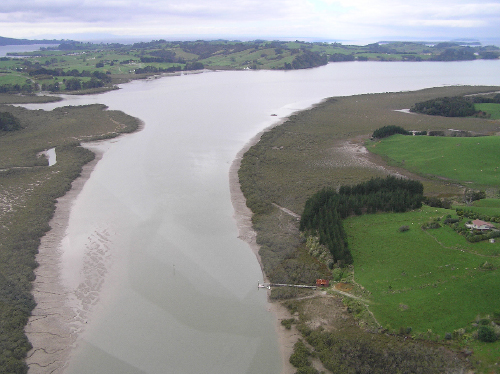
Muddy Main Stream: Everything that threatens the Mahurangi Harbour is being worsened by anthropogenic global warming. Longer, dryer spells will likely be broken by more-extreme rainfall events—a recipe for an increasingly elevated sediment accumulation rate and an increasingly stressed benthic community. image Auckland Regional Council
In an ideal world, the Mahurangi Magazine would stick to its knitting.
It could focus on the environment of the Mahurangi catchment, particularly the harbour’s elevated sediment accumulation rate. In this ideal world, the global, big picture issue of anthropogenic global warming would be so well covered by mainstream media and so well addressed by mainstream political leaders, that the Mahurangi Magazine would be left to focus on the local detail.
The Mahurangi is geographically well placed to showcase practical climate action—or it would be if the public transport infrastructure was extended north from its present terminus at Waiwera, with the Mahurangi Coastal Trail. A landscape of outstanding natural beauty, the harbour exemplifies the locales Aucklanders are passionate about protecting from unchecked encroachment by coastal settlement. The regional parks that protect the landscape values of the harbour’s heads are immensely popular and hugely appreciated by town-weary sailors, surprised to find such utter urban respite so close to the metropolis.
Officially, the Mahurangi’s overriding environmental issue is mud. But officialdom worldwide has been slow to comprehend that the anthropogenic global warming emergency requires that longer-understood environmental issues must be vigorously re-examined. Global warming puts the issues of, for example, biodiversity and sustainability, on steroids. It has been established that, as in most catchments, the vast bulk of Mahurangi’s sediment generation occurs during extreme rainfall events. The water-holding capacity of air increases by about 7% per 1° of warming, and a just-published study finds that for every 1° rise, tropical regions will see 10% heavier rainfall events. While the Mahurangi is not tropical, yet, the rainfall message is clear: The rich get richer and the poor get poorer. And while Mahurangi rainfall is projected to fall overall, the Ministry for the Environment warns the region that:
The intensity of ex-tropical cyclones is likely to increase and when these occur there will be an increased risk of damage from heavy rain and strong winds.
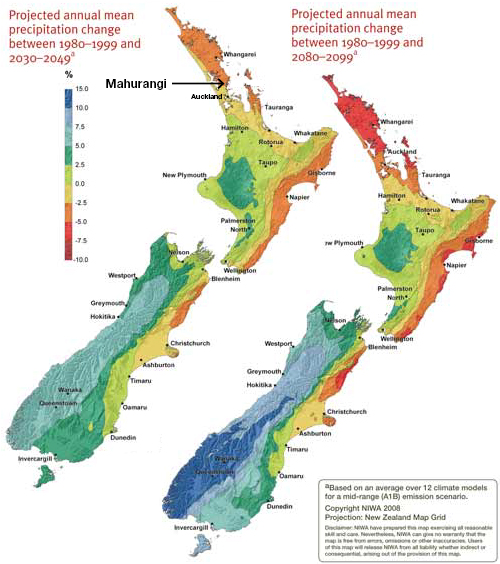
Conservative Projections: With Arctic summer sea ice disappearing far faster than Intergovernmental Panel on Climate Change projections, it is entirely likely that these projected mid-range changes in annual mean rainfall relative to 1990 based on an average over 12 of its climate models for a mid-range (A1B) emission scenario seriously underestimates the impact of global warming on Aotearoa. image Ministry for the Environment Additional label Mahurangi Magazine
The projection of less rain overall but of more-extreme rainfall events is a recipe for deluges that the already muddy Mahurangi desperately does not need. But in addition to increasing sediment generation, the other global warming impact is a reduction in agricultural output, in the face of global population projections of 10–16 billion. If it were not for its strong moral duty to contribute to food production, the Mahurangi catchment might be entirely made over to continuous canopy forest—either for forestry or strictly restoration purposes. The more pragmatic, and at the same time more humane, approach is to simultaneously maximise both food production and tree cover, favouring indigenous species where practicable, in the interests of biodiversity. The potential role for indigenous farm-forestry to be integrated into in Aotearoa’s productive landscapes to enhance existing land use is boundless. For example, productive riparian plantings, shelter, shade that not only increase biodiversity but also are capable of improving current livestock, cropping and food production operations. The sustainable management of the indigenous plants can yield timber, honey, and fibre for cultural and contemporary use and substances for medicinal, herbal, culinary uses, as championed in Weaving Resilience into Our Working Lands.
At present, Auckland Council rules reward planting for restoration purposes, and the protection of mature indigenous stands, with consents to subdivide rural land for residential purposes. There are clear benefits to such policies including increasing biodiversity and reducing sediment generation. On the downside is the loss of agricultural production, the increase in sediment generation from road building and building platform development, and the increase in emissions that is part and parcel of sparse settlement.
Many rural property holders deeply resent that subdivision is invariably the most economic option, short of selling up to wealthy urbanites whose prime interest is location. The high valuation of Mahurangi properties, and thus high local body taxes, invariably reflects the land’s residential rather than productive value, a situation exacerbated by the absurd absence of capital gains taxation in Aotearoa. While it is unlikely to be as economically attractive as subdivision, an alternative is sustainable indigenous farm forestry. This can take the form of managed naturally regenerating indigenous forest, or growing forests from scratch.
An application to the Sustainable Farming Fund is currently being prepared with the aim of showcasing a rich range of indigenous farm-forestry options. With the working title of Mahurangi Indigenous Farm Forestry Demonstration Trail, the proposal is to establish at least seven examples of the productive use of indigenous species in the rural landscape within easy walking distance. The route is the Sandspit Road to Hamilton Road section of the Duck Creek trail that Shelley Trotter suggests should, one day connect the Mahurangi and Matakana wine growing districts.
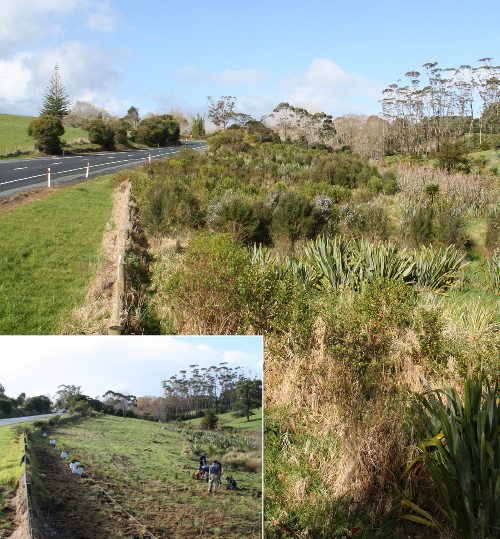
Slashing the Cost at Sandspit Road: Indigenous trees typically cost 20-times more to establish than exotics. This is partly down to the more laborious nursery methods used in the four decades since planter bags were popularised. At this first-ever demonstration comparing open-ground vs. container-raised indigenous plants, the much cheaper forestry-style open-ground plants are more-than holding their own. Images Michael Bergin 2008, 2012
Commencing at The Parsley Pot café, the first demonstration site is an existing Sustainable Farming Fund project where the performance of open-ground and container plants, established in 2007, are being compared. Seedlings raised forestry-style in open-ground beds are a fraction of the price and are free of the potentially crippling root deformities that are common in container-raised plants. While Sandspit Road is only one of four sites where open-ground and container methods are being compared, it is the only one easily accessible by the public—much less one with a café on its doorstep.
This first site, in addition to demonstrating how well open-ground plants compete with much more expensive methods, will see a second phase of planting. Several succession species, such as the indigenous conifer trees tōtara, kauri, rimu, tānekaha and kahikatea and the hardwood trees pūriri, kohekohe, rewarewa and pōhutukawa would be introduced as demonstration stands and their establishment performance within the six different indigenous nurse crop species compared. This will help determine to what extent these species is helped or hindered by, for example, the relatively low growing harakeke or the already two-to-three-metre-tall mānuka. Several of these succession species, including kauri, tōtara, pūriri and rewarewa, are amongst the fastest-growing indigenous trees, given a highly fertile and sheltered site, and should help dispel the misconception that indigenous species are too-slow-growing to be economic for production.
The next site would demonstrate tōtara forestry in particular, and would compare establishment performance of two nurse-crop regimes with several tōtara-only plantings at various spacings. One nurse crop would be the existing sparse mānuka established earlier in the under the Mahurangi Action Plan—competition from grasses has caused the indigenous species planted to struggle. The other nurse crop would be radiata pine, which elsewhere is proving to provide useful competition to young tōtara by encouraging them to grow tall rather than to spread. The radiata pine, once they had served their purpose, would be ring-barked and allowed to dry standing before being harvested for firewood. In the meantime they would not only provide shelter for the developing interplanted tōtara but also serve as bird-perching roosts that would inevitably aid deposition of seed of a range of indigenous species.
The sites described so far lie along Sandspit Road and thus would perform a significant scenic function. They would also visually screen the road and afford some acoustic relief for the farmhouses from the busy road. From here, the trail leads away from Sandspit Road, and follows Duck Creek. While its name may not immediately engender such an image, Duck Creek is a pretty, clear-flowing, tree-shaded stream with a mostly sandstone streambed. The almost pristine condition of the stream is a direct reflection of the care lavished on its uppermost reaches, north of Sandspit Road. These are all now completely fenced and planted, thanks to a farmer passionate about protecting the Mahurangi Harbour—Solway Deer Farm’s Shelley Trotter—and the Mahurangi Action Plan.
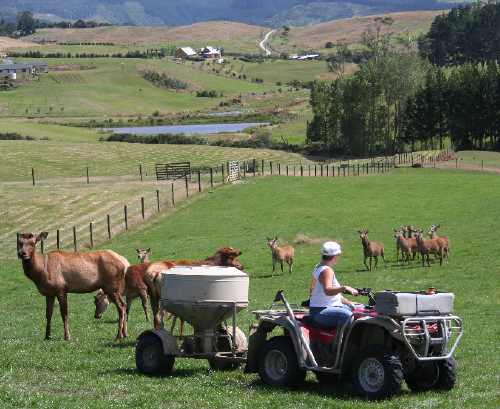
Her Father’s Daughter: When the Mahurangi Action Plan identified Duck Creek as an important subcatchment, it serendipitously found that key farmer Shelley Trotter not only had a family history of riparian protection, but that her environmental degree thesis addressed historic sedimentation rates in Mahurangi Harbour. Solway Deer Farm is now an award-winning demonstration of riparian protection and restoration. image Mahurangi River Winery
Following the stream, the first point of interest would actually be in the adjoining paddock, where individual indigenous trees would be established to demonstrate a variation of agro–forestry. Rather than the usual radiata pine, native species tolerant of open sites such as pūriri, pōhutukawa and tōtara would be grown for the semi-mature tree market. With their propensity to assume lollipop forms, these species are a landscaper’s dream, whether as a feature tree or to line a grand driveway. The economic return could not only be considerably greater than for radiata pine agro–forestry, but rotation could be two to three times faster than growing the legendarily fast-growing exotic to maturity.
The next two demonstrations are mature plantings of exotics, established about 19 years ago. The first is a stand of pecan trees, a species of hickory indigenous to south-central North America. Next is a stand of prolifically bearing chestnuts. Adjacent the chestnuts, and still only half a kilometre from Sandspit Road, the streamside trail reaches the first stand of tōtara regrowth. To the untrained eye, the tall slender, closely spaced trunks look have little productive potential, after their 50–80-year lives. The Northland Tōtara Working Group, however, has proved otherwise. By carefully thinning the stand and then pruning the remaining stems, tōtara have immediately gone from diameter growth rates of 1–2 millimetres per year to up to four times that. It is all about sunlight. By allowing the selected trees to develop bigger canopies, photosynthesis factory floor space is increased. It has been found that, in time, another round of thinning is needed, and another harvest of potentially saleable stems takes place.
With humanity finally registering that urgent climate action is required, locking up carbon in long-lasting products locally made of high-quality indigenous timber is exactly the change from the disposable-plastic petrochemical mindset that is needed.
A little further along the trail, to illustrate a another opportunity, a productive windbreak could be established featuring kahikatea, but also containing a range of hardy indigenous species. Options include single and multi-row shelterbelts, even with a temporary shelter of a fast-growing exotic species. A wide range of indigenous shrub hardwoods that have proven to have fast growth from the nurse crop trials can provide low shelter quickly and in wider multi-row shelterbelsts, scope exists for demonstrating establishment of later successional conifer and hardwood trees as listed above.
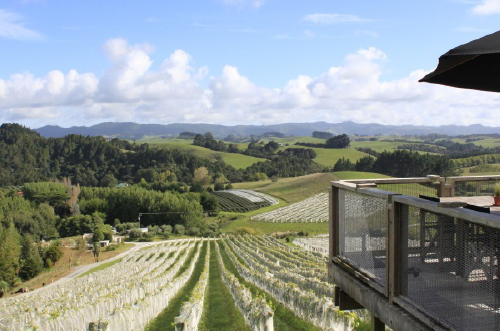
First With the Heart: It would be easy to imagine that Shelley Trotter’s enthusiasm for creating a trail connecting the wine districts of Mahurangi and Matakana sprang from her ownership of the Mahurangi River Winery. In fact, the winery property was purchased primarily for its strategic opportunity to form a hub for a network of Mahurangi trails, however, partner Gary Heaven’s passion for winemaking also helped. image Mahurangi River Winery
A third of a kilometre farther downstream brings the proposed trail to a second, larger stand of tōtara regrowth. But not only is the terrain almost level, making it the perfect environment for parties wishing to learn about tōtara management, the area borders Hamilton Road, and is thus literally two or three paces from the bus door—there is not even a fence to negotiate. In April next year, the New Zealand Farm Forestry Association is holding its annual conference in Ōrewa. The opportunity to include the open-ground and tōtara management demonstration sites in the conference’s field trips is too valuable to pass up. In the event that the Sustainable Farming Fund application is unsuccessful, there will be a Plan B to ensure that the Hamilton Road tōtara site can be readied for demonstration. Either way, it is likely that the one-kilometre trail itself will not be in service by April, or even necessarily within the three-year term of a Sustainable Farming Fund project, as it will possibly depend upon support from other funds.
Once fully developed, the Mahurangi Indigenous Farm-Forestry Demonstration Trail would easily occupy an entire morning of a field day. Participants could be transported to the Parsley Pot Café, and after coffee there, could work their way from site to site, fetching up at the tōtara management demonstration at Hamilton Road. From there, participants could be transported farther along the road to the Mahurangi River Winery for lunch. Or they could walk, a distance of less than a kilometre and a half to the café door. Those with a bit of puff left—the café is perched almost atop a short but steep climb—if they go on the few metres to the hilltop, will be rewarded with a view clear down the Mahurangi Harbour from an elevation of 80 metres.
The winery restaurant is a sublime place to sit, gaze out, and reflect on the visual richness that indigenous farm-forestry is adding, and capable of further adding, to the Mahurangi landscape. And to reflect upon how, through a mixture of restoration planting and production planting, indigenous species can so usefully lock up carbon dioxide that would otherwise be warming the atmosphere. And while the wine grapes in the foreground might not fill many tummies, they do make the most marvellous food for the soul. Steep hillsides under grapevines also generate considerably less sediment than under pasture.
The proposed trail presents an unparalleled opportunity to bring Auckland urban audiences into the heart of sustainable and diversified farming. In addition to the indigenous farm-forestry demonstrated, the landscape includes deer farming, drystock beef, dairying, and wine growing and making. As an integral part of a larger wine trail, the initial proposed farm-forestry demonstration trail might well set the tone for the wider network, as a window on sustainable land use.
In this ideal world, the Mahurangi Magazine would barely need to mention warming.
